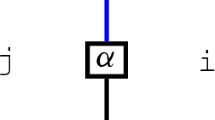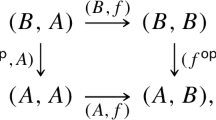Abstract
It is shown that every two-variable adjunction in categories enriched in a commutative quantale serves as a base for constructing Isbell adjunctions between functor categories, and Kan adjunctions are precisely Isbell adjunctions constructed from suitable associated two-variable adjunctions. Representation theorems are established for fixed points of these adjunctions.
Similar content being viewed by others
Data availability statement
Data sharing not applicable to this article as no datasets were generated or analysed during the current study.
Notes
Strictly speaking, “fixed point” should read “pseudo-fixed point” here, since \(a\in \mathsf{Fix}(h)\) satisfies \(ha\cong a\) instead of \(ha=a\).
References
Bělohlávek, R.: Lattices of fixed points of fuzzy Galois connections. Math. Logic Q. 47(1), 111–116 (2001)
Bělohlávek, R.: Concept lattices and order in fuzzy logic. Ann. Pure Appl. Logic 128(1–3), 277–298 (2004)
Bénabou, J.: Les distributeurs. Université Catholique de Louvain, Institute de Matématique Pure et Appliquée, Rapport no. 33 (1973)
Davey, B.A., Priestley, H.A.: Introduction to Lattices and Order, 2nd edn. Cambridge University Press, Cambridge (2002)
Edalat, A., Heckmann, R.: A computational model for metric spaces. Theor. Comput. Sci. 193(1), 53–73 (1998)
Ganter, B., Wille, R.: Formal Concept Analysis: Mathematical Foundations. Springer, Berlin, Heidelberg (1999)
Gray, J.W.: Closed categories, lax limits and homotopy limits. J. Pure Appl. Algebra 19, 127–158 (1980)
Hofmann, D., Seal, G.J., Tholen, W. (eds.): Monoidal Topology: A Categorical Approach to Order, Metric, and Topology, Encyclopedia of Mathematics and its Applications, vol. 153. Cambridge University Press, Cambridge (2014)
Kelly, G.M.: Basic Concepts of Enriched Category Theory, London Mathematical Society Lecture Note Series, vol. 64. Cambridge University Press, Cambridge (1982)
Kostanek, M., Waszkiewicz, P.: The formal ball model for \(\cal{Q}\)-categories. Math. Struct. Comput. Sci. 21(1), 41–64 (2011)
Lai, H., Shen, L.: Fixed points of adjoint functors enriched in a quantaloid. Fuzzy Sets Syst. 321, 1–28 (2017)
Lai, H., Shen, L.: Multi-adjoint concept lattices via quantaloid-enriched categories. Fuzzy Sets Syst. 405, 74–87 (2021)
Lai, H., Zhang, D.: Complete and directed complete \(\Omega \)-categories. Theor. Comput. Sci. 388, 1–25 (2007)
Lai, H., Zhang, D.: Concept lattices of fuzzy contexts: formal concept analysis vs rough set theory. Int. J. Approx. Reason. 50(5), 695–707 (2009)
Lawvere, F.W.: Metric spaces, generalized logic and closed categories. Rendiconti del Seminario Matématico e Fisico di Milano 43, 135–166 (1973)
Medina, J.: Multi-adjoint property-oriented and object-oriented concept lattices. Inf. Sci. 190, 95–106 (2012)
Medina, J., Ojeda-Aciego, M., Ruiz-Calviño, J.: Formal concept analysis via multi-adjoint concept lattices. Fuzzy Sets Syst. 160(2), 130–144 (2009)
Pawlak, Z.: Rough sets. Int. J. Comput. Inf. Sci. 11(5), 341–356 (1982)
Polkowski, L.: Rough Sets: Mathematical Foundations, Advances in Intelligent and Soft Computing, vol. 15. Physica-Verlag, Heidelberg (2002)
Popescu, A.: A general approach to fuzzy concepts. Math. Logic Q. 50(3), 265–280 (2004)
Riehl, E.: Category Theory in Context. Dover Modern Math Originals, Dover Publications, Mineola, Aurora (2016)
Rosenthal, K.I.: Quantales and their Applications, Pitman Research Notes in Mathematics Series, vol. 234. Longman, Harlow (1990)
Rutten, J.J.M.M.: Weighted colimits and formal balls in generalized metric spaces. Topol. Appl. 89(1), 179–202 (1998)
Shen, L.: Adjunctions in quantaloid-enriched categories. PhD thesis, Sichuan University, Chengdu (2014)
Shen, L., Zhang, D.: Categories enriched over a quantaloid: Isbell adjunctions and Kan adjunctions. Theory Appl. Categ. 28(20), 577–615 (2013)
Shulman, M.: Homotopy limits and colimits and enriched homotopy theory. arXiv:math/0610194 (2006)
Stubbe, I.: Categorical structures enriched in a quantaloid: categories, distributors and functors. Theory Appl. Categ 14(1), 1–45 (2005)
Stubbe, I.: Categorical structures enriched in a quantaloid: tensored and cotensored categories. Theory Appl. Categ 16(14), 283–306 (2006)
Yao, Y.: Concept lattices in rough set theory. In: Proceedings of 2004 Annual Meeting of the North American Fuzzy Information Processing Society (NAFIPS 2004), vol. 2, pp. 796–801. IEEE (2004)
Acknowledgements
The authors would like to thank Professor Hongliang Lai and Professor Dexue Zhang for helpful discussions. The authors would also like to thank the anonymous referee for valuable comments and suggestions which significantly improve the presentation of the paper.
Author information
Authors and Affiliations
Corresponding author
Ethics declarations
Conflict of interest
The authors declare that they have no conflict of interest.
Additional information
Communicated by Maria Manuel Clementino.
Publisher's Note
Springer Nature remains neutral with regard to jurisdictional claims in published maps and institutional affiliations.
This work was supported by National Natural Science Foundation of China (No. 12071319).
Rights and permissions
About this article
Cite this article
Shen, L., Tang, X. Isbell Adjunctions and Kan Adjunctions via Quantale-Enriched Two-Variable Adjunctions. Appl Categor Struct 30, 223–245 (2022). https://doi.org/10.1007/s10485-021-09654-w
Received:
Accepted:
Published:
Issue Date:
DOI: https://doi.org/10.1007/s10485-021-09654-w




